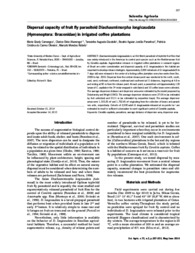Dispersal capacity of fruit fly parasitoid Diachasmimorpha longicaudata (Hymenoptera: Braconidae) in irrigated coffee plantations.
Dispersal capacity of fruit fly parasitoid Diachasmimorpha longicaudata (Hymenoptera: Braconidae) in irrigated coffee plantations.
Author(s): CAMARGOS, M. G.; ALVARENGA, C. D.; GIUSTOLIN, T. A.; PARANHOS, B. A. J.; OLIVEIRA, P. C. do C.; RABELO. M. M.
Summary: Diachasmimorpha longicaudata is an Old World parasitoid of tephritid fruit flies that was widely introduced in the Americas to control pest species such as the Mediterranean fruit fly Ceratitis capitata. Augmentative releases in irrigated coffee plantations in semiarid regions of Brazil are under consideration and dispersal capacity of D. longicaudata in this habitat are important to develop release strategies. Approximately 2,000 individuals of D. longicaudata (5 to 7 days old) were released in the center of a fruiting coffee plantation every two weeks from Dec. 2009 to Apr. 2010. Dispersal from the central release point was monitored to the north, south, east, west, northeast, northwest, southeast and southwest at 11 distances, beginning at 4.6 m and ending at 90 m from the release point. At each point, a parasitism unit (approximately 120 larvae of C. capitata in the 3rd instar wrapped in voile fabric) and 10 coffee beans were collected. The average dispersion distance and dispersion area were estimated by the model proposed by Dobzhansky and Wright (1943). The average dispersion distances were 27.06 m (as estimated by fruit collection) and 33.11 m (as estimated by oviposition traps). The average dispersion areas were 1,315.25 m 2 and 1,752.45 m2 originating from the collection of beans and parasitism units, respectively. Cohorts of 2,000 adult D. longicaudata released at six points ha−1 are estimated to result in sufficient colonization to exert significant control of Ceratitis capitata.
Publication year: 2016
Types of publication: Journal article
Unit: Embrapa Semi-arid Region
Observation
Some of Embrapa's publications are published as ePub files. To read them, use or download one of the following free software options to your computer or mobile device. Android: Google Play Books; IOS: iBooks; Windows and Linux: Calibre.
Access other publications
Access the Agricultural Research Database (BDPA) to consult Embrapa's full library collection and records.
Visit Embrapa Bookstore to purchase books and other publications sold by Embrapa.

